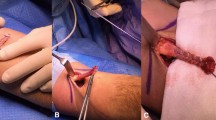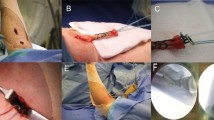Abstract
Introduction
The rupture of the distal biceps tendon is a relatively uncommon lesion. Even if conservative treatment may be an option in low demanding patients, young and active subjects may benefit from an early surgical reinsertion. Many techniques and fixation devices have been described, but in the literature, there are no clinical evidences that show the superiority of any of these. In this article, we report an analysis of the “state of the art” and our case series of surgical reinsertion with the double approach transosseous technique.
Materials and methods
Between 2003 and 2013, 26 patients underwent surgical reinsertion, either for acute or for chronic lesions of distal biceps tendon. We evaluated 21 acute cases treated with double approach using DASH and SECEC Elbow Scores. The mean follow-up was 22 months. Range of motion, supination and flexion strength were also recorded.
Results
Mean final ROM was 6–132° in F/E and 89–0–87° in P/S; flexion and supination strength were 96 and 88 % compared to the opposite side. The main complications were two cases of heterotopic ossifications: one asymptomatic fracture of the proximal radius and one temporary neurapraxia of the radial nerve.
Conclusions
Analysing the literature and our outcomes, we underline the importance of timing for surgery, in young and compliant patients, with a valid rehabilitation protocol for excellent results. The choice of surgical technique remains controversial, and we believe that the double approach transosseous reinsertion is a safe, costless and relatively non-invasive technique, offering satisfactory results when performed early.



Similar content being viewed by others
References
Safran MR, Graham SM (2002) Distal biceps tendon ruptures: incidence, demographics, and the effect of smoking. Clin Orthop Relat Res 404:275–283
Gilcreest EL (1936) Dislocation and elongation of the long head of the biceps brachii: an analysis of six cases. Ann Surg 104(1):118–138
Morgenthaler M, Weber M (1999) Pathological rupture of the distal biceps tendon after long-term androgen substitution. Z Orthop Ihre Grenzgeb 137:368–370
Preston FS, Adicoff A (1961) Hyperparathyroidism with avulsion at three major tendons. N Engl J Med 266(19):968–971
Cirincione RJ, Baker BE (1975) Tendon ruptures with secondary hyperparathyroidism: a case report. J Bone Joint Surg 57A:852–853
Murphy KJ, McPhee I (1965) Tears of major tendons in chronic acidosis with elastosis. J Bone Joint Surg 47A(6):1253–1258
Wener JA, Schein AJ (1974) Simultaneous bilateral rupture of the patellar tendon and quadriceps expansions in systemic lupus erythematosus: a case report. J Bone Joint Surg 56A(4):823–824
Ruland RT, Dunbar RP, Bowen JD (2005) The biceps squeeze test for diagnosis of distal biceps tendon ruptures. Clin Orthop Relat Res 437:128–131
O’Driscoll SW, Goncalves LB, Dietz P (2007) The hook test for distal biceps tendon avulsion. Am J Sports Med 35:1865–1869
Lobo Lda G, Fessell DP, Miller BS, Kelly A, Lee JY, Brandon C, Jacobson JA (2013) The role of sonography in differentiating full versus partial distal biceps tendon tears: correlation with surgical findings. AJR Am J Roentgenol 200(1):158–162
Giuffre BM, Moss MJ (2004) Optimal positioning for MRI of the distal biceps brachii tendon: flexed abducted supinated view. AJR Am J Roentgenol 182:944–946
Azar FM (2008) Traumatic disorders. In: Canale ST, Beaty JH (eds) Campbell’s operative orthopaedics, 11 edn. Mosby Elsevier, Philadelphia, pp 2775–2776
Baker BD, Bierwagen D (1985) Rupture of the distal tendon of the biceps brachii: operative versus nonoperative treatment. J Bone Joint Surg Am 67:414–417
Chillemi C, Marinelli M, De Cupis V (2007) Rupture of the distal biceps brachii tendon: conservative treatment versus anatomic reinsertion—clinical and radiological evaluation after 2 years. Arch Orthop Trauma Surg 127:705–708
Klonz A, Loitz D, Wohler P, Reilmann H (2003) Rupture of the distal biceps brachii tendon: isokinetic power analysis and complications after anatomic reinsertion compared with fixation to the brachialis muscle. J Shoulder Elbow Surg 12:607–611
Sutton KM (2010) Surgical treatment of distal biceps rupture. J Am Acad Orthop Surg 18(3):139–148
Sarda P et al (2013) Distal biceps tendon rupture: current concepts. Injury Int J Care Injured 44:417–420
Boyd HB, Anderson LD (1961) A method for reinsertion of the distal biceps brachii tendon. J Bone Joint Surg Am 43(1041–3):19
Morrey BF, Askew LJ, An KN, Dobyns JH (1985) Rupture of the distal tendon of the biceps brachii. A biomechanical study. J Bone Joint Surg Am 67:418–421
Widmer BJ (2010) Treatment of distal biceps tendon ruptures. Am J Orthop 39(6):288–296
Miyamoto RG (2010) Distal biceps tendon injuries. J Bone Joint Surg Am 92(11):2128–2138
Karunakar MA et al (1999) Distal biceps ruptures. A followup of Boyd and Anderson repair. Clin Orthop Related Res 363:100–107
Sotereanos DG, Pierce TD, Varitimidis SE (2000) A simplified method for repair of distal biceps tendon ruptures. J Shoulder Elbow Surg. 9(3):227–233
Balabaud L, Ruiz C, Nonnenmacher J, Seynaeve P, Kehr P, Rapp E (2004) Repair of distal biceps tendon ruptures using a suture anchor and an anterior approach. J Hand Surg Br. 29(2):178–182
McKee MD, Hirji R, Schemitsch EH et al (2005) Patient-oriented functional outcome after repair of distal biceps tendon ruptures using a single-incision technique. J Shoulder Elbow Surg 14(302–306):20
Sl Siebenlist, Fischer SC, Sandmann GH, Ahrens P, Wolf P, Stöckle U, Imhoff AB, Brucker PU (2014) The functional outcome of forty-nine single-incision suture anchor repairs for distal biceps tendon ruptures at the elbow. Int Orthop. 38(4):873–879
Bain GI et al (2000) Repair of distal biceps tendon rupture: a new technique using the Endobutton. J Shoulder Elbow Surg 9(2):120–126
Kodde IF, van den Bekerom MP, Eygendaal D (2015) Reconstruction of distal biceps tendon ruptures with a cortical button. Knee Surg Sports Traumatol Arthrosc 23(3):919–925
El-Hawary R, Macdermid JC, Faber KJ, Patterson SD, King GJ (2003) Distal biceps tendon repair: comparison of surgical techniques. J Hand Surg Am 28:496–502
Grewal R et al (2012) Single versus double-incision technique for the repair of acute distal biceps tendon ruptures. A randomized clinical trial. J Bone Joint Surg Am 3(94):1166–1174
Shields E, Olsen JR, Williams RB, Rouse L, Maloney M, Voloshin I (2015) Distal biceps brachii tendon repairs: a single-incision technique using a cortical button with interference screw versus a double-incision technique using suture fixation through bone tunnels. Am J Sports Med [Epub ahead of print]
Mazzocca AD, Burton KJ, Romeo AA, Santangelo S, Adams DA, Arciero RA (2007) Biomechanical evaluation of 4 techniques of distal biceps brachii tendon repair. Am J Sports Med 35(2):252–258
Berlet GC, Johnson JA, Milne AD, Patterson SD, King GJ (1998) Distal biceps brachii tendon repair: an in vitro biomechanical study of tendon reattachment. Am J Sports Med 26:428–432
Lemos SE, Ebramzedeh E, Kvitne RS (2004) A new technique: in vitro suture anchor fixation has superior yield strength than bone tunnel fixation for distal biceps tendon repair. Am J Sports Med 32:406–410
Quach T (2010) Distal biceps tendon injuries—current treatment options. Bull NYU Hosp Joint Dis 68(2):103–111
Greenberg JA, Fernandez JJ, Wang T, Turner C (2003) Endobutton—assisted repair of distal biceps tendon ruptures. J Shoulder Elbow Surg 12:484–490
Conflict of interest
The authors declare that they have no conflict of interest.
Human and animal rights
This article does not contain any studies with human or animal subjects performed by any of the authors.
Author information
Authors and Affiliations
Corresponding authors
Rights and permissions
About this article
Cite this article
Giacalone, F., Dutto, E., Ferrero, M. et al. Treatment of distal biceps tendon rupture: why, when, how? Analysis of literature and our experience. Musculoskelet Surg 99 (Suppl 1), 67–73 (2015). https://doi.org/10.1007/s12306-015-0360-5
Received:
Accepted:
Published:
Issue Date:
DOI: https://doi.org/10.1007/s12306-015-0360-5




